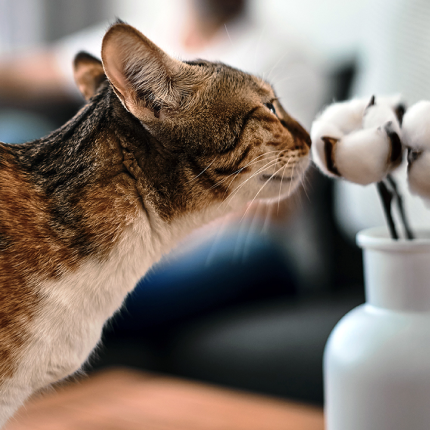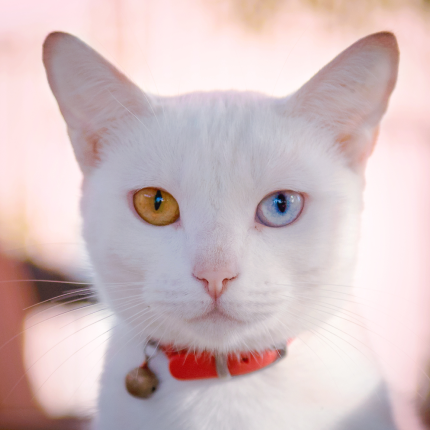The Amazing Power of Your Cat’s Sense of Smell

Compared to humans, cats have a 14x stronger sense of smell. This is because the cat’s nasal organ has a larger capacity than the human’s and is probably the most important sensory organ of a cat is her nose.
The sense of smell is vital to the survival of cats. In addition to sniffing out food, mates, and enemies, cats also use scent to mark the boundaries of their territories. Scents and odors are the cat’s world.
advertisement
Smell and food
Kittens are born blind and use their sense of smell to locate their mothers right after birth and latch onto their teats to eat. As a result, a cat’s sense of smell will always lead it to food, even if it is in an unlikely location, such as high tree branches or kitchen cabinets.
Any cat with an active upper respiratory infection or an aging cat with a limited sense of smell may stop eating their food because taste is closely associated with smell. To stimulate its appetite and increase the odor, warming the cat’s food can help.
Smell and reproduction
Cats in heat (in the estrus cycle) exude a powerful sex pheromone that males can smell from a mile away. You’ll appreciate this phenomenon if you’ve witnessed lusting tomcats outside your home while your unspayed female cat tries to escape. It is also possible for female cats to scent out a preferred mate by smelling his territorial markings.
Smell and territory
Male cats mark their territories with urine or pheromones from glands on their faces and feet. Frequently they will travel their territorial boundaries, sniffing at their markings and reapplying when the odor diminishes. As other male cats smell the markings, they will either respect the territory or try to take it over by introducing their scent markings.
Have you ever seen a cat enter the outdoors with its head held alert, whiskers twitching, and nostrils wide open? During this stance, the cat sniffs out potential harm and gathers information about recent passersby. With the help of olfactory accessory organs, their nose can tell if another cat has recently ventured near or if there is fish in the delivery truck next door.
The Jacobson’s organ
The vomeronasal organ of cats (as well as snakes and a few other mammals) is also known as Jacobson’s organ. Located in the nasal septum, just above the roof of the mouth, it connects the nasal cavity to the rest of the body. Cats can open Jacobson’s organ ducts by wrinkles and lifting their lips. It is sometimes described as a slightly open-mouthed “smile” when the cat brings air into the Jacobson’s organ, known as the flehmen response. No matter the size or species of a cat, the Jacobson’s organ appears to play a significant role in their sense of smell.
advertisement
Nose Care
It depends on the cat’s genetics and basic coloring, whether its nose leather is black or pink. The surface of the nose is tough and leathery, but it is living tissue that can become infected. White and light-colored cats are prone to squamous cancer of the nose and ears, as are all mammals.
Cats frequently exposed to the sun over a long time are more likely to develop this cancer. Veterinarian-approved sunscreens are available that are compounded for use on a cat’s delicate nose and ear tips if it frequently gets sunburned there.

Featured Articles

Greebles and Cats: The Origin and the Meaning
You may have seen an internet sensation concerning cats labeled “greebles.” Feel out of the loop? We’re here to help you. In 2019, Reddit user /user/literallyatree commented on a Reddit post about a cat that looks like it’s trying to slap a ghost. This user commented: “My family calls things…

Polydactyl Cats: Just More Beans to Love
Polydactyl cats have become extremely popular in recent times. As a result, more and more people are interested in learning more about this six-toed cat and want to get one of their own. If you are a cat lover intrigued by polydactyl cats, you have come to the right place….

The Odd-Eyed Cat (AKA Heterochromia)
Cats are already beautiful and fascinating creatures, but people are bound to take notice when they have something as captivating as two different colored eyes. Odd-eyed cats always have one blue eye paired with either a green, yellow, or brown eye. This form of heterochromia occurs in other animals, including…
